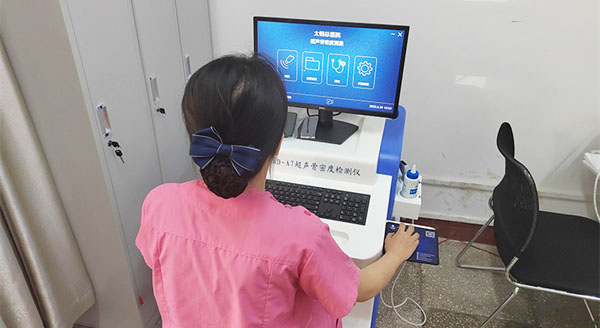When the ultrasound bone density test report shows “reduced bone mass” (with a T value ranging from -1 to -2.5), many people fall into anxiety: Does this mean osteoporosis? Is it necessary to take medicine immediately? In fact, reduced bone mass is a “warning signal” sent by bones, but there are far more ways to improve it than just medication.
Have you been hit by the “hidden culprits” of reduced bone mass?
Bone health is not static. After the age of 35, bone mass begins to naturally decrease, and many habits in modern life are accelerating this process:
Dietary imbalance: A survey by the Chinese Nutrition Society shows that over 80% of adults have insufficient calcium intake, and a high-salt diet (daily salt intake > 5g) can lead to a 23% increase in urinary calcium loss.
Lack of exercise: The World Health Organization points out that 27.5% of adults worldwide lack exercise, and the rate of bone density decline among sedentary people is twice that of the average person.
Insufficient light exposure: Vitamin D is synthesized through skin contact with ultraviolet rays, but the average outdoor activity time of modern people is less than one hour per day, resulting in a vitamin D deficiency rate as high as 80%.
The accumulation of these factors causes the bones to gradually become “in deficit”, eventually leading to a reduction in bone mass.
Two. Three-step safety improvement: Diet, exercise, and monitoring
1. Dietary adjustment: Eating to achieve “bone density
The Dietary Guidelines for Chinese Residents clearly recommend that adults should consume 800 to 1000mg of calcium and 400IU of vitamin D daily. These foods are natural “bone supplements” :
High-calcium combination: 300ml milk (containing 300mg of calcium) + 100g northern tofu (containing 164mg of calcium) + 200g Chinese kale (containing 196mg of calcium), easily meeting daily needs.
Vitamin D fortification: Consume deep-sea fish (such as 100g of salmon, which contains 570IU of vitamin D) twice a week, or get 15-30 minutes of sun exposure every day (avoiding the strong midday light) to promote the synthesis of vitamin D in the skin.
Taboo list: Reduce caffeine intake (no more than 2 cups of coffee per day), avoid high-salt pickled foods, and consume oxalic acid-rich vegetables (such as spinach which needs to be blanched before consumption) to prevent calcium loss.
As the ancients said, “Grains are for nourishment and fruits are for assistance.” A balanced diet is the foundation of bone health.
2. Exercise Enhancement: Build “Bone Strength” through movement
Bones need “pressure stimulation” to remain vigorous. The exercise program recommended by the World Health Organization is as follows:
Weight-bearing exercises: Brisk walking, jogging or rope skipping 3 to 5 times a week (30 minutes each time), stimulating bone formation through the reaction force of the ground.
Resistance training: Dumbbell exercises and resistance band training twice a week to enhance muscle strength and reduce the risk of falls (falls are the primary cause of osteoporotic fractures).
Balance exercises such as Tai Chi and standing on one foot can enhance neuromuscular coordination and reduce the risk of accidental falls.
The Inner Classic of the Yellow Emperor states, “The body is tired but not weary.” Moderate exercise is the key to health preservation – the intensity of exercise should be such that one sweats slightly and can speak but not sing.
3. Regular monitoring: Early detection and early intervention
Worried about bone health, it is recommended to have a bone density test once a year.
Key groups of concern: Postmenopausal women, people over 65 years old, those who have been using glucocorticoids for a long time, and those with a family history of fractures.
Risk assessment: By integrating fracture risk assessment and taking into account factors such as age, gender, and bone density, predict the probability of fractures in the next 10 years.
Early detection and early intervention are the key to “taking precautions in advance and preventing problems before they occur”.
Youdaoplaceholder0. Have you avoided these misunderstandings?
Misconception 1: “Reduced bone mass = osteoporosis”
Reduced bone mass is the early stage of osteoporosis and can be reversed through intervention. However, if left untreated, it may develop into osteoporosis within 5 to 10 years.
Misconception 2: “The more calcium you take, the better.”
Excessive calcium supplementation (more than 2000mg per day) may cause kidney stones and vascular calcification, which is actually harmful to health.
Misconception 3: “Young people won’t have reduced bone mass.”
Young people who have long-term diets, lack exercise and stay up late may lose bone mass faster than their peers – bone health knows no age limit!
Health is the persistence that accumulates day by day
In the face of reduced bone mass, we need not panic, nor should we blindly seek “shortcuts”. Starting from today, drink one more glass of milk, walk for 20 more minutes, and get 10 more minutes of sun exposure – these seemingly minor changes are the warmest care for your bones.
After all, health is never something that can be achieved overnight; rather, it is the result of persistent efforts accumulated over time. May we all be able to protect the “youthful state” of our bones in a scientific way!
Post time: Jul-01-2025


